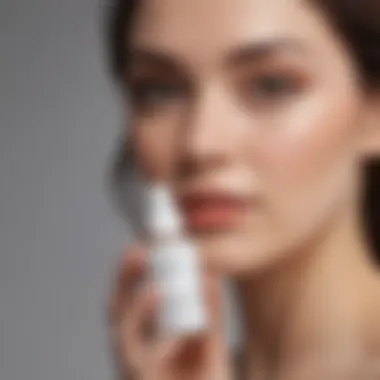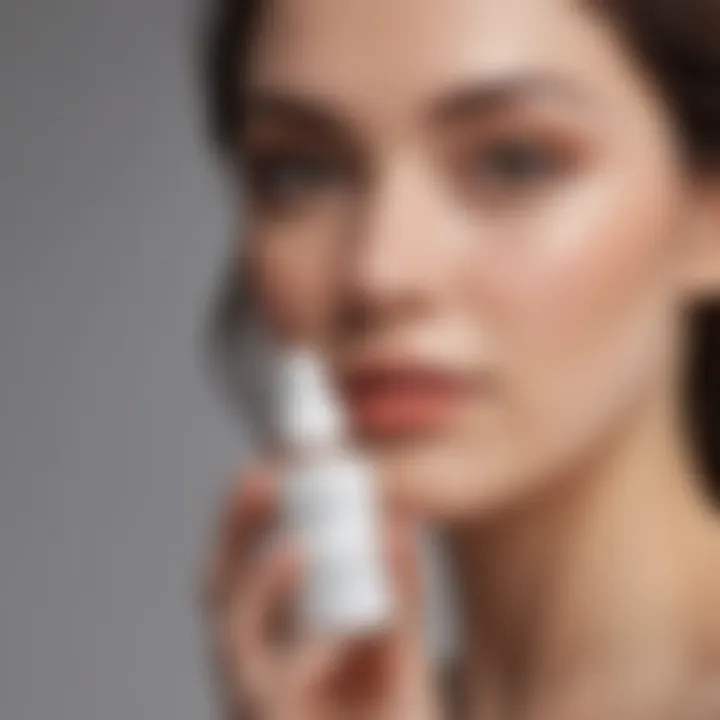Discovering the Benefits of Oil-Free Moisturizers with Niacinamide


Intro
As the world of skincare continues to evolve, consumers are becoming more discerning about the products they choose. Among these products, oil-free moisturizers featuring niacinamide are gaining significant traction. Not only do these moisturizers cater to a diverse range of skin types, but they also address common skin concerns such as dryness, dullness, and uneven texture.
Niacinamide, or vitamin B3, is well-regarded for its ability to improve skin barrier function and regulate oil production. But why might a person opt for an oil-free moisturizer? For skin that is prone to breakouts or feels heavy with traditional creams, an oil-free option can offer relief without sacrificing hydration.
This guide aims to unwrap the multifaceted benefits of oil-free moisturizers with niacinamide by exploring their ingredients, effectiveness, and sustainable practices related to their formulation. We will navigate through skincare tips tailored for various skin types and how to integrate these products seamlessly into daily routines. Together, we’ll also investigate the essence of quality formulation and sustainable sourcing in skincare, ensuring you make the most informed choices possible.
Stay with us as we embark on this enlightening journey through the world of oil-free moisturizing solutions, where efficacy meets sustainability in skincare.
Key Trends
Overview of Current Trends in Skincare
The demand for oil-free moisturizers has sharply increased among consumers who strive for impeccable skin without the greasy feel that often accompanies traditional products.
In the realm of skincare, the current trend favors lightweight, effective products that contain beneficial active ingredients like niacinamide. Some notable points include:
- Transparency in ingredients: Consumers are keen on knowing what goes into their products and prefer formulas with clear, health-focused labels.
- Minimalist skincare routines: People are simplifying their nightly rituals, focusing on fewer quality products rather than a lengthy process.
- Inclusivity for all skin types: Whether oily, dry, or combination skin, there’s a push for universal formulations to meet varying needs.
Popular Beauty Trends
In addition to skincare, the beauty industry is witnessing a rise in eco-consciousness and sustainability. As these movements gain momentum, key beauty trends are forming around them.
- Clean beauty: This trend emphasizes the use of non-toxic, natural ingredients, with brands striving for more ethical sourcing.
- Skinimalism: A style that embraces minimal makeup, allowing skin to shine through, complements the oil-free moisturizer movement effectively.
- Tech advancements: Innovative beauty products incorporating smart technology for customized skincare routines are emerging, ensuring that individual needs are prioritized effectively.
"Consumers today want products that not only enhance their beauty but also respect their values and the environment."
As skincare continues to recognize evolving consumer desires, the connection between effective ingredients and conscious practices strengthens. In turn, oil-free moisturizers enriched with niacinamide are at the forefront of this positive shift.
Preamble to Oil-Free Moisturizers
The landscape of skincare is evolving, and among the most significant innovations are oil-free moisturizers. With a growing emphasis on the need for lightweight hydration, many individuals are turning to these formulations. The subject of oil-free moisturizers is not just a passing trend; it has deep implications for how we understand skin health and hydration. This guide will explore their relevance, particularly when they are combined with niacinamide, a powerhouse ingredient revered for its multifaceted benefits.
In essence, oil-free moisturizers can be defined as products designed to hydrate the skin without the use of traditional oils. This formulation can be particularly beneficial for those with oily or acne-prone skin, as heavy oils can exacerbate these conditions. It allows for a more breathable experience, providing moisture while keeping pores clear. For women navigating the complexities of skincare—whether due to hormonal changes, environmental factors, or simply aging—understanding oil-free options becomes crucial.
Moreover, the modern skincare consumer is well-informed and increasingly seeking products that offer more than just basic hydration. They are looking for solutions that address specific concerns like uneven texture, enlarged pores, and overall skin luminosity. Oil-free moisturizers, particularly those infused with niacinamide, can deliver on these expectations, making them an excellent choice for anyone aiming to simplify and enhance their skincare routine. As we delve deeper into this topic, we'll uncover the specific aspects that make these formulations worthy of attention.
Understanding Niacinamide
Gaining a solid grasp of niacinamide is crucial for anyone venturing into the realm of oil-free moisturizers. This powerhouse ingredient not only boasts remarkable benefits for various skin types but also enhances the overall efficacy of oil-free formulations. By delving into its properties and historical usage, we can appreciate its significance in modern skincare solutions.
What is Niacinamide?
Niacinamide, also known as Vitamin B3, has gained fame as a beloved skincare staple in recent years. It’s a water-soluble vitamin that plays an essential role in maintaining skin health. Incorporating niacinamide into your skincare can lead to improved skin texture and increased hydration.
The beauty of niacinamide lies in its multifunctionality. It can soothe inflammation, enhance the skin's natural barrier, and promote an even skin tone, making it a versatile choice for those struggling with various skin concerns. Think of it as your skin's best friend—able to assist with issues ranging from acne and rosacea to signs of aging.
Perhaps one of the most attractive features of niacinamide is its gentleness; it’s well-tolerated by most skin types, even those prone to sensitivity. This means that regardless of whether you’re battling oily streaks or dry patches, niacinamide acts like a nurturing hug for your skin.
Historical Context and Uses in Skincare
Niacinamide's roots stretch back to the early 20th century when researchers began unearthing its health benefits. Initially, it was recognized for its role in preventing pellagra, a nutritional deficiency linked to a shortfall of niacin in diets. Over time, its skin-enhancing properties started to catch the attention of dermatologists.
As the beauty industry's understanding of ingredients evolved, niacinamide was spotlighted for its numerous applications: skincare formulations adopted it as a key ingredient for its brightening capabilities and ability to mitigate the effects of environmental stressors. Its inclusion in moisturizers represents a significant advancement, as consumers seek formulas that not only hydrate but also provide a myriad of additional skin benefits.


The ongoing research and countless user testimonials have only solidified its place in the skincare routine. Today, you can find niacinamide in a multitude of products, ranging from serums to lotions, each promising to address specific skin issues. The combination of historical significance and modern efficacy positions niacinamide as a skincare ingredient that deserves careful consideration.
Mechanism of Action
Understanding the mechanism of action behind niacinamide in oil-free moisturizers is pivotal for anyone keen on enhancing their skincare routine. The way niacinamide functions at a cellular level can illuminate its profound impact on skin health and aesthetics. This section will unravel how niacinamide, a form of Vitamin B3, engages with various skin functions and its interactive role with the skin barrier.
How Niacinamide Affects Skin Function
Niacinamide is thought to work wonders due to its multifaceted capabilities. When applied to the skin, it dives into the deeper layers and starts to transform skin conditions.
One of its primary benefits is enhancing the skin's natural barrier function. This is often likened to repairing a sturdy wall that protects a house; a robust barrier prevents external aggressors from sneaking in and causing havoc. With niacinamide, you might say this "wall" gets a fresh coat of paint and fortification.
Niacinamide plays a role in increasing the production of ceramides, which are lipid molecules that maintain hydration and protect against moisture loss. A well-hydrated skin is less likely to show signs of aging, thus promoting a youthful appearance. Moreover, niacinamide can help regulate the production of sebum, which is beneficial for those with oily or combination skin types. This double action of ensuring hydration while controlling oil is particularly special, and that's why people with diverse skin needs tend to benefit.
Furthermore, niacinamide enhances cellular turnover, leading to a more radiant complexion by reducing the appearance of dullness and improving overall skin tone. Imagine a factory where each part is enhanced to function efficiently, creating products that shine — this is niacinamide at work, helping your skin keep its glow.
Interaction with Skin Barrier
The interaction of niacinamide with the skin barrier is critical to its efficacy. The skin barrier, akin to a fortress, is responsible for safeguarding the body from environmental damage while retaining essential moisture. When niacinamide enters this arena, it acts like the skilled architect needed to identify weak spots.
Niacinamide reinforces the skin barrier by increasing its lipid content and boosting the production of proteins like keratin. This protective quality becomes significant, particularly in hostile environmental conditions — be it pollution, UV rays, or changing climates. Its soothing properties also help to calm inflammation, which can otherwise compromise the integrity of the skin barrier.
In practice, this means that when you consistently use oil-free moisturizers containing niacinamide, you're not only moisturizing but also actively strengthening your skin's defense mechanisms. Over time, this leads to improved resilience, making the skin less susceptible to harsh environmental factors.
"With consistent use, niacinamide empowers your skin, allowing it to become a stronger, more radiant version of itself."
In summary, when we delve into the mechanics of how niacinamide interacts with skin function and the barrier, we uncover a world of benefits that go beyond merely moisturizing. The potential for rejuvenating and protecting the skin paves the way for healthier complexions as well as increased confidence.
Benefits of Niacinamide in Oil-Free Moisturizers
In the realm of skincare, the dialogue surrounding niacinamide is increasingly vivid, especially when it comes to oil-free moisturizers. This ingredient is more than just a trend; it's a powerful ally for those seeking hydration without the heaviness that oils often impart. By focusing on niacinamide's role within these formulations, we can understand how it addresses several skin concerns while offering significant benefits.
Enhancing Hydration Without Grease
One of the standout features of niacinamide is its ability to hydrate effectively without introducing greasiness. For many individuals, especially those with oily skin, traditional moisturizers can feel like a slippery slope, doing more harm than good. Oil-free formulations that incorporate niacinamide strike a balance; they replenish the skin without clogging pores.
Niacinamide works by supporting the skin’s natural moisture retention. It helps to strengthen the skin barrier, optimizing moisture levels while preventing transepidermal water loss. This means that even the oiliest skin types can enjoy hydration without the associated shine or residue. The end result is skin that feels supple and looks radiant without an oily finish.
Improving Skin Texture and Tone
Another impressive benefit of niacinamide in oil-free moisturizers is its ability to improve both skin texture and tone. Imagine a product that not only hydrates but also reduces the appearance of pores; that’s niacinamide in action. This ingredient has been shown to promote a more even complexion by minimizing discoloration and enhancing skin clarity.
By stimulating collagen production, niacinamide also contributes to improved skin elasticity over time. Users often report a smooth texture and a reduction in hyperpigmentation, acne scars, or uneven skin tone. So, it’s not just about looking good; it's about feeling confident in your skin’s appearance.
Regulating Oil Production
For individuals battling shiny skin and breakouts, niacinamide provides a welcome solution by regulating oil production. It helps the skin maintain a healthy balance, ensuring it doesn’t overproduce sebum, which often leads to clogged pores and ensuing blemishes. This is particularly beneficial for those with combination skin who require moisture without the added oil flow.
Incorporating niacinamide into an oil-free moisturizer can help achieve that elusive balance. The soothing properties of niacinamide also aid in calming inflammation, further preventing the triggers that might lead to an oily, problematic complexion. Smaller pores and a reduction in shine are often seen as a big win for those integrating these products into their routine.
Overall, niacinamide adds a level of sophistication to oil-free moisturizers, making them suitable for a wide range of skin types.
Whether it’s enhancing hydration without making skin slick, improving texture and tone, or regulating oil, niacinamide proves its worth in oil-free formulations. Thus, understanding these benefits is crucial for anyone looking to optimize their skincare approach.
Identifying the Right Product
Selecting the appropriate oil-free moisturizer that features niacinamide is pivotal for anyone looking to optimize their skincare routine. With myriad options flooding the market, the nuances in formulation can make or break the desired outcomes. Understanding product labels and concentrations not only ensures you’re making an informed choice but also empowers you to tailor your skincare regimen to your unique needs. This section aims to delve into the intricacies of identifying the right product and the benefits that come with it.


Understanding Ingredients Labels
When eyeing a moisturizer, comprehension of ingredients labels is essential. Most products will list components in descending order by quantity. Thus, you want to watch for niacinamide appearing prominently among the first few ingredients. If it’s near the bottom, it’s likely not delivering the punch you are looking for.
Common ingredients often found alongside niacinamide include hyaluronic acid, which aids in hydration, and various botanical extracts, which might provide additional skin benefits. By familiarizing yourself with these common pairings, you can more easily assess the overall quality of the product.
Consider also the presence of potential irritants, like fragrances or alcohols. These ingredients can derail the benefits of niacinamide, especially for those with sensitive skin. Thus, it’s advisable to keep an eye on labels and possibly consult resources such as Wikipedia and Britannica for understanding specific ingredients.
Checking Concentration Levels of Niacinamide
Once you’ve deciphered the ingredients label, the next step involves gauging the concentration levels of niacinamide itself. The effectiveness of this ingredient can vary significantly based on its concentration. Generally, a concentration of 5% to 10% is considered effective for most users. Higher concentrations, around 10% to 20%, may yield more pronounced benefits but could lead to irritation for some.
For a quick check, many brands indicate the concentration on the packaging, which can be a helpful guide. If you’re looking into a particular product but can’t find this information, a little research or a peek at customer reviews on platforms like Reddit can often shed light on user experiences and product effectiveness.
Putting it all together, finding an oil-free moisturizer that satisfies both the ingredient integrity and concentration of niacinamide will set you up for success in your skincare journey. It narrows the playing field to products that can provide substantial benefits: hydration without excess oils, a more refined skin texture, and management of oil production, all of which can contribute positively to your overall skin health.
"Understanding ingredients labels and concentrations transforms your skincare experience from guesswork into informed choices."
Integrating Oil-Free Moisturizers into Skincare Routine
Integrating oil-free moisturizers into your daily skincare routine is crucial for maintaining healthy, hydrated skin without the heaviness that traditional creams can sometimes impose. Many women, regardless of their age or skin type, often find themselves juggling between the right products that both hydrate and do not clog pores. That’s where oil-free moisturizers containing niacinamide come into play.
These formulations can offer lightweight hydration while actively promoting skin health. Especially for those who have oily or combination skin, oil-free moisturizers prevent the greasy shine that other products may leave behind. They work together with niacinamide to balance oil production and provide a comfortable, non-greasy feel.
Morning and Evening Applications
Establishing a consistent routine for applying oil-free moisturizers is vital. Morning applications help prep the skin for the day ahead, ensuring it stays hydrated amidst environmental aggressors. When selecting a product for daytime use, choose a formula that absorbs quickly. This ensures it's not competing with your makeup, should you wear any.
In the evening, the skin enters a regenerative phase. Applying an oil-free moisturizer that contains niacinamide helps repair and rejuvenate the skin overnight. When the body is at rest, it absorbs nutrients more effectively. Using it before bedtime can promote better skin texture and assist with issues like dullness or uneven tone during these crucial hours.
Layering with Other Products
Layering products correctly is an art. After applying oil-free moisturizers, particularly those with niacinamide, you can enhance their effectiveness by adding serums or treatments tailored to your specific skin concerns.
- Order Matters: Always begin with your thinnest products first. Start with any serums, then follow up with your oil-free moisturizer.
- Know Your Combinations: Niacinamide pairs well with several ingredients, such as hyaluronic acid for hydration or antioxidants like vitamin C. Avoid layering with ingredients like copper peptides or acids that might conflict with niacinamide.
- Adjust Based on Skin Feel: As the seasons change from summer to winter, your skin’s hydration might need a boost. An oil-free moisturizer may be layered with a lightweight oil in winter months for extra nourishment without becoming too heavy.
"Using skincare products in the right order can maximize their effects, resulting in clearer and healthier skin overall."
Integrating oil-free moisturizers into your routine allows you to customize your skincare experience. By focusing on the specific needs of your skin, utilizing niacinamide can help you strike that perfect balance between hydration and freshness, keeping skin looking its best all year round.
Target Audience for Oil-Free Niacinamide Products
Understanding the target audience for oil-free niacinamide products is crucial for effectively navigating the skincare landscape. These products cater specifically to individuals who have unique skin needs, and knowing whom they benefit the most can enhance one's skincare regimen. Why is this important? Well, selecting the right moisturizer can help improve skin health, boost confidence, and address common concerns such as oiliness, dryness, and uneven skin tone.
Who Benefits the Most?
Oil-free niacinamide moisturizers are particularly advantageous for several groups of people:
- Individuals with Oily or Combination Skin: Those grappling with excess oil can find solace in oil-free formulas. These moisturizers deliver hydration without the added grease, striking a balance that leaves the skin feeling refreshed.
- Acne-Prone Skin Types: Niacinamide possesses anti-inflammatory properties, thus it can help reduce redness and soothe irritation associated with breakouts. Consequently, this ingredient is often hailed as a hero for those dealing with acne-related woes.
- Sensitive Skin: For those with sensitive skin, the soothing nature of niacinamide is beneficial. It can reduce transepidermal water loss and enhance the skin barrier, making it less reactive to external irritants.
- Individuals Seeking Anti-Aging Properties: As we age, maintaining moisture while combating signs of aging becomes vital. Niacinamide can help improve skin elasticity and promote a more youthful texture.
These groups stand to gain the most from integrating oil-free niacinamide moisturizers into their routines, as each will have specific benefits that address their concerns.
Skin Types and Concerns Addressed
When evaluating oil-free niacinamide products, it's essential to consider various skin types and the specific issues they face:
- Oily Skin: This skin type often produces excess sebum, leading to a shine that many prefer to avoid. An oil-free moisturizer with niacinamide contributes hydration while actively regulating oil production.
- Combination Skin: Those with a combination skin type face the challenge of balancing different areas of the face. Niacinamide helps even out skin tone and texture, making it a versatile choice.
- Dry Skin: While dry skin may seem counterintuitive for oil-free products, niacinamide can aid in boosting hydration levels without introducing additional oils that might exacerbate texture issues.
- Sensitive Skin: People with sensitive skin may find traditional creams too heavy or irritating. Instead, niacinamide offers a light and soothing alternative that minimizes negative reactions.
- Sun-Damaged or Hyperpigmented Skin: Niacinamide can inhibit the production of melanin, helping to lighten areas of darkened skin, thus it’s valuable for those wanting to even their skin tone after sun exposure.


Potential Side Effects and Precautions
Understanding potential side effects and precautions when using oil-free moisturizers with niacinamide is vital for anyone looking to enhance their skincare routine. While niacinamide is generally well-tolerated and offers numerous benefits, it's not totally without its flaws. Knowing what to watch out for can make the difference between a harmonious relationship with your skin and one that's a bit rocky. This section will clarify common reactions and advocate for careful testing practices.
Common Reactions to Niacinamide
Even with its impressive profile, niacinamide can trigger some reactions in certain individuals. Here are a few tidbits worth taking note of:
- Skin Irritation: This might manifest as redness, itching, or burning sensations, especially for people with sensitive skin types.
- Initial Breakouts: A few users might experience breakouts upon first introductions. This can often be attributed to skin adjustment rather than a true allergy, but it's still wise to keep an eye on it.
- Dryness or Peeling: For those who already struggle with skin dryness, incorporating new products too quickly can exacerbate the issue, leading to flaky patches.
It's essential to recognize these responses aren't universal; many enjoy the benefits without encountering any issues. However, being aware of the potential pitfalls can help users make informed choices about their skincare and avoid unwelcome surprises.
Patch Testing and Best Practices
So, how can one safely integrate an oil-free moisturizer with niacinamide into their routine? The answer lies in patch testing, a savvy practice that can save a lot of headaches down the line.
- Select a small area of skin: Usually, the forearm is a great choice. It's easy to cover and doesn't interfere with daily life.
- Apply a small amount: Use a pea-sized amount of the product in that area, then wait and watch for 24 to 48 hours.
- Monitor for reactions: If redness, itching, or any severe reaction occurs, it’s a red flag that this product might not be suitable for your skin.
- Don’t rush the process: It can be tempting to dive headfirst into a new skincare regimen, but gradual introduction is often more effective. Begin with once daily usage before deciding to increase frequency.
Remember, even with gentle formulas, finding the right fit for your skin takes time.
"Taking small steps is often the best way to navigate the world of skincare. Your skin will thank you for the patience."
Implementing these best practices ensures you’re not only embracing the perks of niacinamide but also protecting your skin from the unexpected. It's about finding balance; with the right precautions, oil-free moisturizers can be a fabulous addition to anyone’s skincare toolkit.
Sustainability and Ethical Considerations
In recent years, the conversation surrounding skincare has increasingly gravitated towards sustainability and ethical practices. This chapter underscores the importance of these topics when discussing oil-free moisturizers formulated with niacinamide. As consumers become more aware of the environmental footprint left by personal care products, the demand for transparency in sourcing and packaging has grown exponentially.
Sustainability goes beyond just using eco-friendly ingredients; it encompasses the entire life cycle of a product—from the moment of sourcing ingredients to the packaging that encases them. When we talk about niacinamide specifically, it’s crucial to consider how it is sourced and the continued impact this has on our planet.
Sourcing Niacinamide Ethically
Ethical sourcing of niacinamide plays a pivotal role in ensuring that this ingredient does not contribute to harm to ecosystems or communities. Niacinamide is most commonly derived from vitamin B3, which can either be synthesized in labs or extracted from natural sources, like yeast. While both methods can be sustainable, what matters is how these processes are conducted.
- Transparent Supply Chains: Brands that prioritize ethical sourcing maintain clear supply chains where the origins of their ingredients can be traced. This transparency fosters accountability and ensures that farmers and workers are treated fairly.
- Supporting Local Communities: Sourcing materials locally can often have a positive impact, as it supports community economies and reduces carbon emissions related to transportation.
- Certifications Matter: When choosing products, look for certifications like Fair Trade or Organic. These labels often indicate that brands are engaging in responsible practices, covering everything from labor rights to sustainable farming techniques.
By demanding higher standards in ingredient sourcing, consumers can drive change and encourage brands to adopt practices that are not only ethical but also environmentally friendly.
Impact of Packaging on Environmental Health
Packaging, often overlooked, is a significant player in the sustainability conversation. The materials used to contain products can have a long-lasting impact on environmental health.
- Material Choices: The type of material—be it plastic, glass, or biodegradable alternatives—affects the overall sustainability of a product. Plastics, especially single-use ones, contribute heavily to pollution and can take hundreds of years to decompose. On the other hand, biodegradable materials are finding their way into skincare lines, yet require responsible disposal methods to truly minimize their impact.
- Recyclability: Brands that use recyclable materials not only help reduce waste but also encourage consumers to engage in recycling practices. Clear instructions on how to recycle should be provided on the packaging to guide users.
- Minimalist Packaging: Emphasizing minimalism not only reduces waste but can also appeal to consumers looking for environmentally friendly options. Brands focusing on less is more may find a receptive audience in consumers eager to lessen their footprints.
"In a world where every choice counts, opting for products with sustainable packaging is a step towards a healthier planet."
Culmination
In summing up the importance of integrating oil-free moisturizers with niacinamide into skincare routines, it becomes clear that this duo stands out for a variety of reasons. First, such formulations cater to a diverse audience—from those with oily skin to individuals prone to breakouts. Niacinamide is notable for its multifaceted role in enhancing skin health while remaining gentle, bringing valuable benefits to hydration, texture, and oil regulation.
Recap of Key Insights
As we've explored throughout this guide, key insights emerge:
- Hydration without heaviness: Niacinamide allows for moisturization without contributing to excess oil, making it a great option for anyone wanting to keep their skin fresh and comfortable.
- Texture and tone enhancement: Regular use of niacinamide-infused products can lead to improved skin appearance, effectively minimizing the look of pores and fine lines.
- Regulation of oil production: By influencing sebum production, niacinamide can help in maintaining balance for those who struggle with oiliness but still seek moisture.
These insights highlight the critical role that niacinamide plays, especially when paired with oil-free moisturizers. It's clear that selecting the right products could lead to healthier, more resilient skin.
Future of Oil-Free Niacinamide Moisturizers
Looking ahead, the future of oil-free niacinamide moisturizers seems promising. Trends in skincare are shifting towards clean, effective formulations, and niacinamide is in the spotlight. As companies focus on ethical sourcing and sustainable packaging, it's vital for consumers to remain informed.
- Evolving formulations: There might be innovations that dive deeper into optimizing niacinamide concentrations and combining them with complementary ingredients for enhanced effects.
- Growing popularity: As more consumers become aware of the benefits of niacinamide, the demand for inclusive and effective products is likely to grow.
- Sustainability considerations: With environmental consciousness on the rise, forming partnerships with companies prioritizing ethical practices could further propel the positive trajectory of these products.



